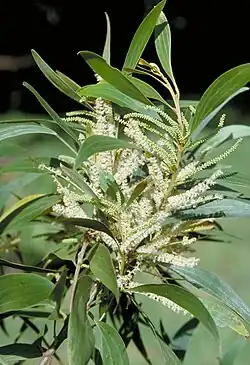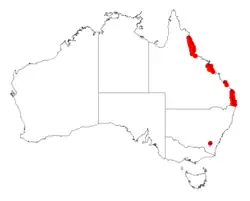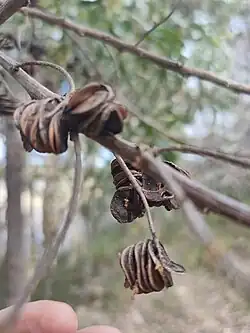Acacia cincinnata
| Daintree wattle | |
|---|---|

| |
| Flowers | |
| Scientific classification | |
| Kingdom: | Plantae |
| Clade: | Tracheophytes |
| Clade: | Angiosperms |
| Clade: | Eudicots |
| Clade: | Rosids |
| Order: | Fabales |
| Family: | Fabaceae |
| Subfamily: | Caesalpinioideae |
| Clade: | Mimosoid clade |
| Genus: | Acacia |
| Species: | A. cincinnata
|
| Binomial name | |
| Acacia cincinnata | |

| |
| Occurrence data from AVH | |
| Synonyms[1] | |
|
Racosperma cincinnatum (F.Muell.) Pedley | |

Acacia cincinnata, commonly known as Daintree wattle or circle fruit salwood,[2] is a species of flowering plant in the family Fabaceae and is endemic to Queensland, Australia. It is a large shrub or tree with furrowed flaky bark, hairy branchlets, very narrowly elliptic phyllodes, spikes of creamy yellow flowers and tightly, spirally coiled, leathery pods.
Description
Acacia cincinnata is a large shrub or tree that typically grows to a height of 5–25 m (16–82 ft) and has been recorded with a dbh of 60 cm (24 in). It has furrowed, flaky dark grey to black bark. The branchlets are stout, angular, pale brownish grey and covered with soft hairs. The phyllodes very narrowly elliptic, 100–160 mm (3.9–6.3 in) long and 11–30 mm (0.43–1.18 in) wide, leathery and tapered at both ends with 3 main veins and a gland 2 mm (0.079 in) from the base of the phyllode. The flowers are borne in spikes 35–55 mm (1.4–2.2 in) long and are creamy yellow. Flowering occurs from May to June and the pods are elliptic to oblong, tightly spirally coiled, mostly 5–6 mm (0.20–0.24 in) wide, glabrous, leathery and covered with a white, powdery bloom. The seeds are black and 35–45 mm (1.4–1.8 in) long.[2][3][4][5]
Taxonomy
Acacia cincinnata was first formally described in 1878 by the botanist Ferdinand von Mueller in his Fragmenta Phytographiae Australiae from specimens collected by John Dallachy.[6][7] The specific epithet (cincinnata) means 'possessing curled hair'.[8]
Distribution and habitat
This species of wattle is endemic to Queensland where it is found near the margins of rainforest in damper parts of the Atherton Tableland, the adjacent coast, the Eungella Range and the high rainfall areas between Maryborough and Brisbane, often in sandy soils over granite.[4]
See also
References
- ^ a b "Acacia cincinnata". Australian Plant Census. Retrieved 30 June 2025.
- ^ a b F.A.Zich; B.P.M.Hyland; T.Whiffen; R.A.Kerrigan (2020). "Acacia cincinnata". Australian Tropical Rainforest Plants Edition 8 (RFK8). Centre for Australian National Biodiversity Research (CANBR), Australian Government. Retrieved 20 June 2021.
- ^ Kodela, Phillip G.; Tindale, Mary D. Kodela, Phillip G. (ed.). "Acacia cincinnata". Flora of Australia. Australian Biological Resources Study, Department of Climate Change, Energy, the Environment and Water: Canberra. Retrieved 30 June 2025.
- ^ a b "Acacia cincinnata". World Wide Wattle. Western Australian Herbarium. Retrieved 26 August 2019.
- ^ "Acacia cincinnata F.Muell". Wattle - Acacias of Australia. Lucid Central. Retrieved 26 August 2019.
- ^ "Acacia cincinnata". APNI. Retrieved 30 June 2025.
- ^ von Mueller, Ferdinand (1878). Fragmenta Phytographiae Australiae. Melbourne: Victorian Government Printer. pp. 35–36. Retrieved 30 June 2025.
- ^ George, Alex S.; Sharr, Francis A. (2023). Western Australian Plant Names and Their Meanings - A Glossary (fifth ed.). Kardinya: Four Gables Press. p. 165. ISBN 9780645629538.